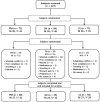The effects of daily intake timing of almond on the body composition and blood lipid profile of healthy adults
- PMID: 29209458
- PMCID: PMC5712498
- DOI: 10.4162/nrp.2017.11.6.479
The effects of daily intake timing of almond on the body composition and blood lipid profile of healthy adults
Abstract
Background/objectives: Timing of almond intake during a day may result differently in the perspectives of body composition and changes of lipid profile. The current study was conducted to compare the effects of daily almond intake as a preload versus as a snack on body composition, blood lipid profile, and oxidative and inflammation indicators among young Korean adults aged 20-39 years old.
Subjects/methods: Participants were randomly assigned to one of three groups: a pre-meal almond group (PM), a snack almond group (SN) in which participants were instructed to consume 56 g of almonds either as a preload before meals or as a snack between meals, respectively, and a control group (CL) in which participants were provided high-carbohydrate iso-caloric control food. Measurements were performed at baseline, weeks 8 and 16.
Results: A total of 169 (M 77/F 92) out of the 227 participants completed the study between June 2014 and June 2015 (n = 58 for PM; 55 for SN; and 56 for CL). A significant decrease in body fat mass was observed in the PM group at both weeks 8 and 16 compared with the CL. There were significant intervention effects on changes of body fat mass (P = 0.025), body fat percentages (P = 0.019), and visceral fat levels (P < 0.001). Consuming almonds as a daily snack reduced the levels of total cholesterol (P = 0.043) and low-density lipoprotein (LDL) cholesterol (P = 0.011) without changing high-density lipoprotein (HDL) cholesterol compared with the CL.
Conclusion: Almond consumption as a preload modified body fat percentages, whereas snacking on almonds between meals improved blood lipid profiles. This trial was registered at ClinicalTrials.gov as NCT03014531.
Keywords: Almonds; body composition; snacking.
Conflict of interest statement
CONFLICT OF INTEREST: The authors declare no potential conflicts of interests.
Figures
Similar articles
-
Time and Intervention Effects of Daily Almond Intake on the Changes of Lipid Profile and Body Composition Among Free-Living Healthy Adults.J Med Food. 2018 Apr;21(4):340-347. doi: 10.1089/jmf.2017.3976. Epub 2018 Jan 9. J Med Food. 2018. PMID: 29315019 Free PMC article. Clinical Trial.
-
The effect of almonds on vitamin E status and cardiovascular risk factors in Korean adults: a randomized clinical trial.Eur J Nutr. 2018 Sep;57(6):2069-2079. doi: 10.1007/s00394-017-1480-5. Epub 2017 Jul 10. Eur J Nutr. 2018. PMID: 28695324 Free PMC article. Clinical Trial.
-
Almond consumption improved glycemic control and lipid profiles in patients with type 2 diabetes mellitus.Metabolism. 2011 Apr;60(4):474-9. doi: 10.1016/j.metabol.2010.04.009. Epub 2010 May 23. Metabolism. 2011. PMID: 20580779 Clinical Trial.
-
Almonds have a neutral effect on serum lipid profiles: a meta-analysis of randomized trials.J Am Diet Assoc. 2009 May;109(5):865-73. doi: 10.1016/j.jada.2009.02.014. J Am Diet Assoc. 2009. PMID: 19394473 Review.
-
[Simple obesity in children. A study on the role of nutritional factors].Med Wieku Rozwoj. 2006 Jan-Mar;10(1):3-191. Med Wieku Rozwoj. 2006. PMID: 16733288 Review. Polish.
Cited by
-
Effect of almond consumption on insulin sensitivity and serum lipids among Asian Indian adults with overweight and obesity- A randomized controlled trial.Front Nutr. 2023 Jan 10;9:1055923. doi: 10.3389/fnut.2022.1055923. eCollection 2022. Front Nutr. 2023. PMID: 36704786 Free PMC article.
-
Tracking the Risk of Cardiovascular Disease after Almond and Oat Milk Intervene or Statin Medication with a Powerful Reflex SH-SAW POCT Platform.Sensors (Basel). 2024 Oct 10;24(20):6517. doi: 10.3390/s24206517. Sensors (Basel). 2024. PMID: 39459999 Free PMC article.
-
Perspective: Challenges and Future Directions in Clinical Research with Nuts and Berries.Adv Nutr. 2023 Sep;14(5):1005-1028. doi: 10.1016/j.advnut.2023.07.010. Epub 2023 Aug 2. Adv Nutr. 2023. PMID: 37536565 Free PMC article.
-
Time and Intervention Effects of Daily Almond Intake on the Changes of Lipid Profile and Body Composition Among Free-Living Healthy Adults.J Med Food. 2018 Apr;21(4):340-347. doi: 10.1089/jmf.2017.3976. Epub 2018 Jan 9. J Med Food. 2018. PMID: 29315019 Free PMC article. Clinical Trial.
-
Ingesting Nuts Can Regulate Adipokines Expression in Individuals Living with Overweight and Obesity: A Narrative Review of What Is Known So Far.Nutrients. 2025 Jun 27;17(13):2138. doi: 10.3390/nu17132138. Nutrients. 2025. PMID: 40647244 Free PMC article. Review.
References
-
- U.S. Department of Agriculture. USDA National Nutrient Database for standard reference. Release 28 [Internet] Washington, D.C.: U.S. Department of Agriculture; 2016. [cited 2016 November 12]. Available from: http://ndb.nal.usda.gov.
-
- Bolling BW, Chen CY, McKay DL, Blumberg JB. Tree nut phytochemicals: composition, antioxidant capacity, bioactivity, impact factors. A systematic review of almonds, Brazils, cashews, hazelnuts, macadamias, pecans, pine nuts, pistachios and walnuts. Nutr Res Rev. 2011;24:244–275. - PubMed
-
- Li SC, Liu YH, Liu JF, Chang WH, Chen CM, Chen CY. Almond consumption improved glycemic control and lipid profiles in patients with type 2 diabetes mellitus. Metabolism. 2011;60:474–479. - PubMed
Associated data
LinkOut - more resources
Full Text Sources
Other Literature Sources
Medical


